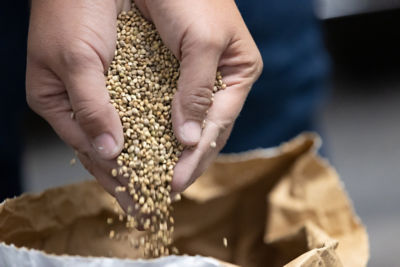Causal Agent
Insufficient or excessive nutrients
Distribution
Worldwide
Symptoms
Nitrogen (N): Plants under low N stress are smaller than normal and have an overall light-green color, especially in the lower leaves. Fruits are small with thin walls. Excess nitrogen fertilizer can cause leaf and fruit burning, especially if applied as an ammonium formulation.
Phosphorus (P): Leaves on deficient plants are smaller than normal and dark-green. Older leaves are affected first and, in severe cases, may senesce.
 Phosphorus deficient (left) and healthy (right) pepper seedlings.
Phosphorus deficient (left) and healthy (right) pepper seedlings.
Potassium (K): Symptoms of K deficiency begin on older leaves and progress to younger leaves. Foliage develops bronzing and/or burning of leaf margins and may develop chlorosis. Plants are smaller than normal and produce less fruit.
Calcium (Ca): Interveinal chlorosis and leaf margin necrosis occur at the growing points in Ca deficient plants. Later, growing points die. Leaves can be distorted. Fruit may develop blossom-end rot. Excess Ca can cause white spots below the surface of pepper fruit. Openpollinated peppers may develop stip.
Magnesium (Mg): Magnesium deficient plants develop interveinal chlorosis on older leaves, which later progresses to young leaves. Interveinal tissue may become necrotic.
Sulfur (S): Older leaves of S deficient plants turn lightgreen and spindly.
Boron (B): When B is deficient, older leaves turn yellow and brittle, and the growing points become necrotic and die. Margins and leaf tips of mature leaves become necrotic. Fruit may also be affected and develop scattered corky areas and exposed ovaries.

Copper (Cu): Copper deficiency starts as a wilt of young leaves that later turn bluish-green and curl upwards. Severely affected plants are stunted and chlorotic.
Iron (Fe): Young leaves of Fe-deficient plants develop interveinal chlorosis, followed by a general yellowing. The leaf midrib usually remains green.
Manganese (Mn): Young leaves deficient in Mn develop interveinal chlorosis, followed by speckling or necrosis. Midribs of affected leaves remain green.
Zinc (Zn): Leaves deficient in Zn thicken and curl downward. Petioles may twist, and older leaves develop an orange-brown chlorosis.
Conditions for Development
Nutrient deficiencies are most common in acid or alkaline soils due to immobilization of nutrients. Low temperatures, soil compaction or excessive soil moisture may also affect nutrient availability. Nutrient disorders may also be caused by excessive or unbalanced use of fertilizer. Plant diseases that affect plant roots can induce nutrient deficiency symptoms due to reduced nutrient uptake.
Control
Conduct soil and foliar nutrient analyses regularly to verify nutritional needs, design a balanced fertilizer program and correct nutrient imbalances. Alter soil pH with the addition of lime to acid soils or sulfur and acid-forming fertilizers to alkaline soils to increase nutrient availability.




